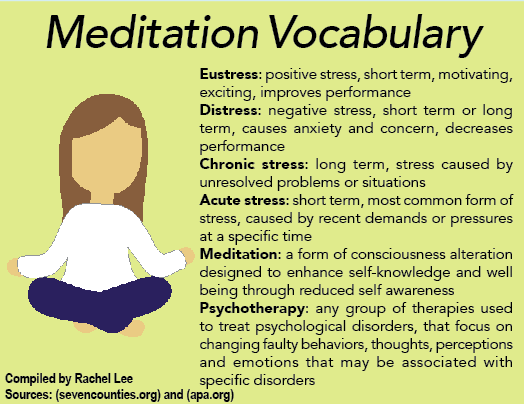According to freshman Sabrina Baxamusa, there are many benefits of lying down on the floor of psychology teacher Robin Walker’s classroom. As the coach of the girls varsity swim team, Walker leads Baxamusa and her teammates in a type of meditation called visualization to prepare them for upcoming events.
Baxamusa said the sessions begin with Walker turning off the lights and directing the swimmers to lie down on the floor. Then he tells the swimmers to relax and imagine themselves in the scenario he describes.
“He tells us a story…it’s usually the same every time,” Baxamusa said.
According to Baxamusa, the purpose of the story is to prepare the team for big swim meets by comparing what happens in the stories to what they want to see happen in the race. One of the recent stories was meant to illustrate getting up on the blocks and starting the race.
“He recently told us to visualize ourselves as a dog chained to a tree,” said Baxamusa. “Then he says, ‘Pretend you’re the dog and you’re finally getting unleashed from the tree.’”
Baxamusa said she then implements the power and strength she imagined during the visualization into her race.
She said she sometimes forgets she is on the floor while she is focused on the visualization. She also does not sense her teammates around her. Although, some distractions interrupt the sessions.
“Often times, the bell would ring while we are visualizing,” said Baxamusa. “It lowers my focus level at times.”
Disregarding these minor interruptions, Baxamusa said she definitely feels the positive impact of meditation on her busy schedule.
“It’s time to myself,” said Baxamusa. “Balancing school with swimming, I don’t have a lot of time to relax.”
Brain studies teacher Michael Piskel has years of experience with a different type of meditation called guided imagery. He said guided imagery is a type of meditation where one puts him or herself “in a relaxed state of mind” by picturing a peaceful scene.
For a session of guided imagery, Piskel follows a specific process where he first focuses on controlling his breathing.
“Put yourself in a receptive spot…the breath is the way you can tap into your nervous system, and you can slow your heart rate down” Piskel said.
Dr. John Astin, a health psychologist, said teenage stress can be caused by a variety of different things. Some of these factors are difficulties or instability at home, bullying and academic pressures at school.
Piskel defines stress as something most people see as negative, but it can also “hold fun or serve as a positive motivator.”
“There’s eustress, like when you ride a roller coaster,” said Piskel. “That can be a fun thing. But [stress] can also be very debilitating, like distress when you’re running for your life from a man-eating tiger.”
Although stress is “inevitable,” Piskel said meditation is highly correlated to stress relief.
“If there’s a stress response in people, there’s also a relaxation response,” said Piskel. “And one of the things that meditation does is it actually causes people to release special hormones in their bodies that counteract the stress hormones.”
Baxamusa said meditating had also helped her improve as an athlete.
“Because visualization makes me so relaxed before meets, I feel like it was able to decrease my time,” said Baxamusa. “It makes me excited to swim.”


